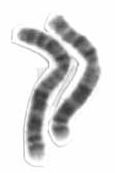
Photo from wikipedia
Amitosis is widespread among eukaryotes, but the underlying mechanisms are poorly understood. The polyploid macronucleus (MAC) of unicellular ciliates divides by amitosis, making ciliates a potentially valuable model system to… Click to show full abstract
Amitosis is widespread among eukaryotes, but the underlying mechanisms are poorly understood. The polyploid macronucleus (MAC) of unicellular ciliates divides by amitosis, making ciliates a potentially valuable model system to study this process. However, a method to accurately quantify the copy number of MAC chromosomes has not yet been established. Here, we used droplet digital PCR (ddPCR) to quantify the absolute copy number of the MAC chromosomes in Tetrahymena thermophila. We first confirmed that ddPCR is a sensitive and reproducible method to determine accurate chromosome copy numbers at the single‐cell level. We then used ddPCR to determine the copy number of different MAC chromosomes by analyzing individual T. thermophila cells in the G1 and the amitotic (AM) phases. The average copy number of MAC chromosomes was 90.9 at G1 phase, approximately half the number at AM phase (189.8). The copy number of each MAC chromosome varied among individual cells in G1 phase and correlated with cell size, suggesting that amitosis accompanied by unequal cytokinesis causes copy number variability. Furthermore, the fact that MAC chromosome copy number is less variable among AM‐phase cells suggests that the copy number is standardized by regulating DNA replication. We also demonstrated that copy numbers differ among different MAC chromosomes and that interchromosomal variations in copy number are consistent across individual cells. Our findings demonstrate that ddPCR can be used to model amitosis in T. thermophila and possibly in other ciliates.
Journal Title: Journal of Eukaryotic Microbiology
Year Published: 2022
Link to full text (if available)
Share on Social Media: Sign Up to like & get
recommendations!